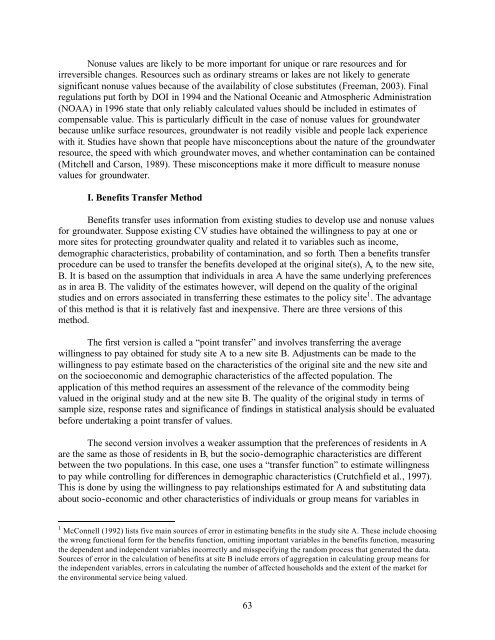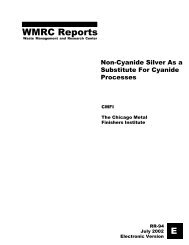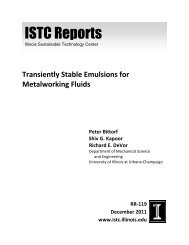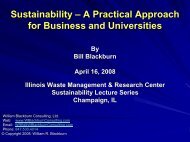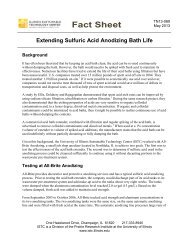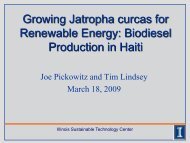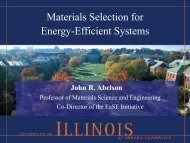Natural Resource Damage Assessment: Methods and Cases
Natural Resource Damage Assessment: Methods and Cases
Natural Resource Damage Assessment: Methods and Cases
Create successful ePaper yourself
Turn your PDF publications into a flip-book with our unique Google optimized e-Paper software.
Nonuse values are likely to be more important for unique or rare resources <strong>and</strong> for<br />
irreversible changes. <strong>Resource</strong>s such as ordinary streams or lakes are not likely to generate<br />
significant nonuse values because of the availability of close substitutes (Freeman, 2003). Final<br />
regulations put forth by DOI in 1994 <strong>and</strong> the National Oceanic <strong>and</strong> Atmospheric Administration<br />
(NOAA) in 1996 state that only reliably calculated values should be included in estimates of<br />
compensable value. This is particularly difficult in the case of nonuse values for groundwater<br />
because unlike surface resources, groundwater is not readily visible <strong>and</strong> people lack experience<br />
with it. Studies have shown that people have misconceptions about the nature of the groundwater<br />
resource, the speed with which groundwater moves, <strong>and</strong> whether contamination can be contained<br />
(Mitchell <strong>and</strong> Carson, 1989). These misconceptions make it more difficult to measure nonuse<br />
values for groundwater.<br />
I. Benefits Transfer Method<br />
Benefits transfer uses information from existing studies to develop use <strong>and</strong> nonuse values<br />
for groundwater. Suppose existing CV studies have obtained the willingness to pay at one or<br />
more sites for protecting groundwater quality <strong>and</strong> related it to variables such as income,<br />
demographic characteristics, probability of contamination, <strong>and</strong> so forth. Then a benefits transfer<br />
procedure can be used to transfer the benefits developed at the original site(s), A, to the new site,<br />
B. It is based on the assumption that individuals in area A have the same underlying preferences<br />
as in area B. The validity of the estimates however, will depend on the quality of the original<br />
studies <strong>and</strong> on errors associated in transferring these estimates to the policy site 1 . The advantage<br />
of this method is that it is relatively fast <strong>and</strong> inexpensive. There are three versions of this<br />
method.<br />
The first version is called a “point transfer” <strong>and</strong> involves transferring the average<br />
willingness to pay obtained for study site A to a new site B. Adjustments can be made to the<br />
willingness to pay estimate based on the characteristics of the original site <strong>and</strong> the new site <strong>and</strong><br />
on the socioeconomic <strong>and</strong> demographic characteristics of the affected population. The<br />
application of this method requires an assessment of the relevance of the commodity being<br />
valued in the original study <strong>and</strong> at the new site B. The quality of the original study in terms of<br />
sample size, response rates <strong>and</strong> significance of findings in statistical analysis should be evaluated<br />
before undertaking a point transfer of values.<br />
The second version involves a weaker assumption that the preferences of residents in A<br />
are the same as those of residents in B, but the socio-demographic characteristics are different<br />
between the two populations. In this case, one uses a “transfer function” to estimate willingness<br />
to pay while controlling for differences in demographic characteristics (Crutchfield et al., 1997).<br />
This is done by using the willingness to pay relationships estimated for A <strong>and</strong> substituting data<br />
about socio-economic <strong>and</strong> other characteristics of individuals or group means for variables in<br />
1 McConnell (1992) lists five main sources of error in estimating benefits in the study site A. These include choosing<br />
the wrong functional form for the benefits function, omitting important variables in the benefits function, measuring<br />
the dependent <strong>and</strong> independent variables incorrectly <strong>and</strong> misspecifying the r<strong>and</strong>om process that generated the data.<br />
Sources of error in the calculation of benefits at site B include errors of aggregation in calculating group means for<br />
the independent variables, errors in calculating the number of affected households <strong>and</strong> the extent of the market for<br />
the environmental service being valued.<br />
63


